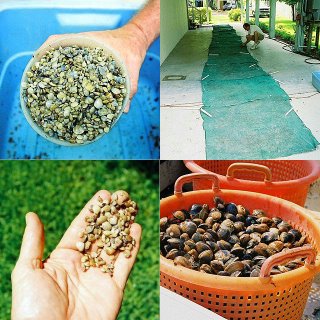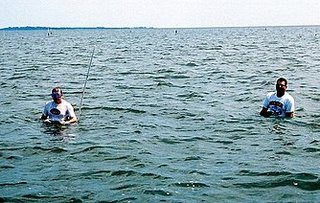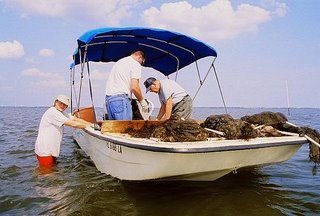
As promised, I got to go clam farming again. This time there was no tropical storm nipping at our heels. In fact, the conditions were perfect with hardly a ripple on the Gulf.
In the collage above, the two left photos are of the tiny clam "seed" that will go into the mesh bags that make up that green clam "belt" in the upper right photo. In that picture, Kelly is zip tying the bags shut.
The bottom right picture is a basket of harvested market size clams.

The photo above shows Kelly and his brother in law Bill preparing to plant the clam belt from the collage pictures. This is the only part that involves a little diving as the belt has to be secured to the bottom.

Most of the harvest took place in low water conditions. The general procedure was to pull a bag of clams from the mud, swish it back and forth to lose the mud, and then lift it up onto the boat. This shot is of Kelly (in water), Bill, and Mr. B.

12 comments:
Thanks for this fascinating series. I guess the only thing I really know about clams is that they miraculously appear in my chowder. I can't figure out why we eat oyster crackers with clam chowder, though.
roger,
thanks. undewater shots on this site would be pretty murky. it's nutrient rich estuary water at the lease. a little offshore from there, it gets pretty nice.
uh...frist? big leagues? confused...
Hal,
That cracker thing is perplexing...
Glad you liked the series. After I type this response, I'm going into the kitchen to make a batch of clam chowder with the clams Kelly gave me :)
Hal,
Forgot to say, I always eat Florida Crackers with my chowder!
Heh!
That looks like a sustainable kind of seafood harvest. Just guessing.
What time is supper?
Betsy,
It really is. The only place they can farm are lease areas that the state has determined to not be a rare or unique habitat. It really is farming.
Rurality,
Well, ya' know any soup tastes better the second day, so tomorrow evening around 6pm is my best guess.
This has been a great series of something I've only done for a short period of time with oysters in Appalachicola Bay one summer.
How long does it take for the clams to become the right size? And (I may have missed this earlier) - are the seed clams produced in aquaculture?
Wayne,
12 to 14 months for complete growout.
The seed clams are produced by indoor recirculating aquaculture systems. They use light and temp to trick the breeder clams to spawn on demand.
Up early!
FC- this is a great photo essay, very informative. And it makes me hungry for clams.
Well...Wayne asked my question...where do all those seed clams come from? Thanks for the answer. This may be a dumb question but how do you tell a breeder clam from a regular clam?
How was the clam chowder? Do you do white or red?
roger,
not lame...I just wasn't culturally literate enough to get it!
Deb,
I'm sure some are on their way to Minnesotarctica restaurants as we speak.
Hick,
The breeder clams have a mischievious glint in their eye.
;)
...actually, the seed suppliers look for clams with superior genetics and keep those in big tanks in a breeding facility. By manipulating light periods and temperature, they can trick the clams into spring spawning at any time of the year.
Clams don't have eyes...now scallops, that's another story...bedroom eyes there.
Hick,
Red.
Post a Comment